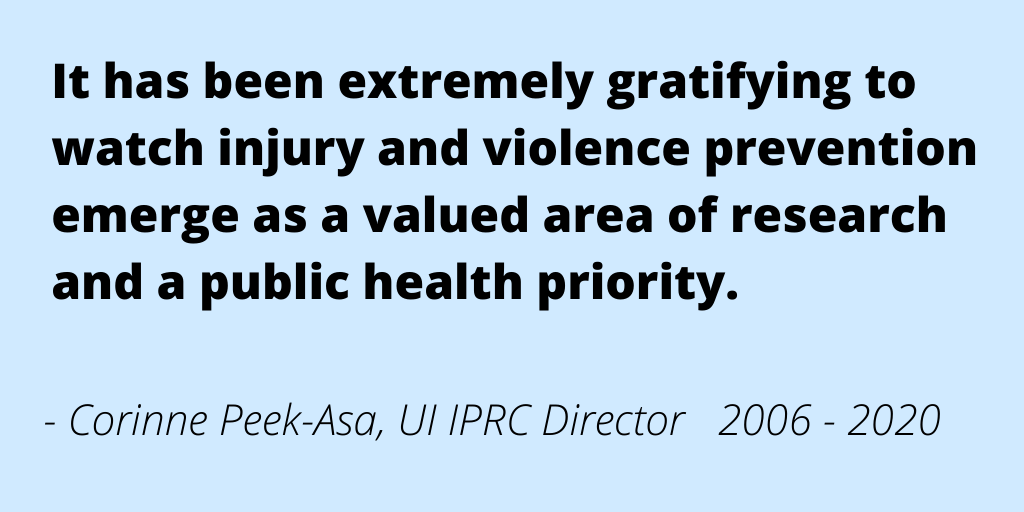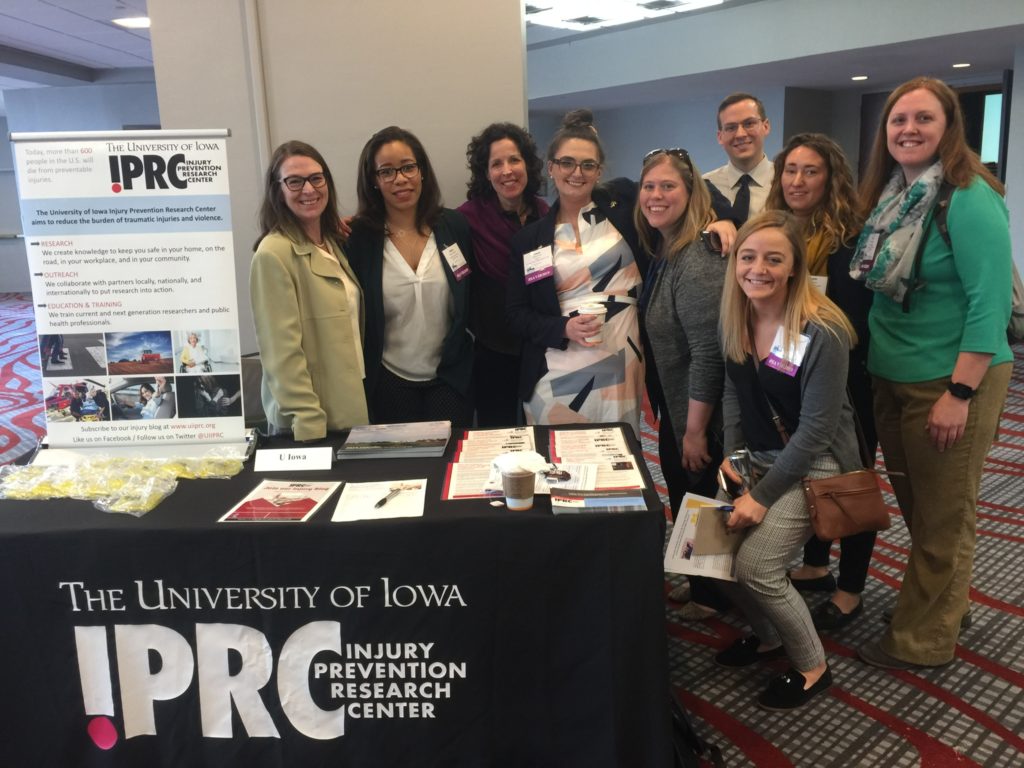This month marked a new and exciting chapter for the UI Injury Prevention Research Center (UI IPRC) as we welcomed Carri Casteel, our center’s associate director for research, into her new role as director of the UI IPRC. We look forward to featuring Dr. Casteel in a fall blog, but this month we celebrate Corinne Peek-Asa, who has served as director since 2006.
Dr. Peek-Asa has led our CDC-funded center with service, passion, and innovation for the last 15 years, and will continue to be part of our leadership team. Because of her vision and expertise, we are truly a “center of excellence” ready to take on the challenges of injury & violence prevention today and in the future.
Here she offers her reflections on the changing technology, power of partnerships, and importance of impact as our center looks ahead.

My first experience with a CDC-funded Injury Control Research Center (ICRC) was as a new graduate student at University of California, Los Angeles (UCLA), where my job involved coding data on motorcycle injuries. It was interesting but arduous work. We had to read through emergency department logs to find motorcycle cases, request the corresponding medical record, and read through an often very thick medical record to collect data, which we then hand-entered into a database.
As I think about the technology available now to identify and glean information from electronic medical records, conduct linkage protocols, and implement complex statistical models, I can’t help but reflect on how much has changed.
Back then when I spoke with others about my work, even within my university, my colleagues were somewhat surprised to hear that I was studying motorcycle injuries as an epidemiologist. What, they wondered, did these “accidents” have to do with public health? And what were we to do about them using our primarily clinical intervention framework?

Individuals, families, and communities were already painfully aware of the burden of traumatic injury because so many had lived it and suffered the consequences. But as a field, we did not yet have a messaging framework, and certainly not the critical mass, to promote the impact that a systematic, evidence-based approach could have on reducing this burden.
So much more than technology has changed since that time, and it has been extremely gratifying to watch injury and violence prevention emerge as a valued area of research and a public health priority.
The CDC’s National Center for Injury Prevention and Control (NCIPC) ICRC program was instrumental in shaping me as an injury and violence epidemiologist, and in shaping a national movement to increase injury and violence research and interventions.
The approach of the ICRCs, and the field itself, has several critical components that make it stand apart. One of the most important, I believe, is collaboration. My work in injury and violence prevention has been inherently engaged and interdisciplinary. I learned early that my work in road traffic safety, and later in other areas, would not be rigorous if I didn’t have perspectives from engineers, psychologists, healthcare providers, communication specialists, among others, as well as state agencies, public health practitioners, community leaders, and policymakers.

Another critical component is impact. I learned that my work would not have the desired impact if I didn’t engage with these broad groups. I have been able to measure the direct impacts of interventions I’ve been involved with in reducing death, physical disability, and psychological aftermath. Not many researchers can be involved in such an actively applied discipline.
When I joined the University of Iowa to become the director of the Injury Prevention Research Center, I didn’t fully realize what a wonderful and rewarding position I was stepping into. Colleagues have become life-long friends. I have worked in an environment that offers creativity, curiosity, and energy. I have been supported to act on wild ideas, guided by colleagues in positive ways when these ideas went wildly wrong, and joined in celebration when they went wildly right. I have been able to continuously learn new things and apply them to my own work.
I have loved serving as the director of the UI IPRC. I am proud of all that we have accomplished – a list that is far too numerous to encompass. We have expanded to include a strong research portfolio of both intentional and unintentional injuries; grew our collaborative base to include more than 60 investigators and leading agencies locally, nationally, and internationally; and have become a national voice on the risk and protective factors and special intervention needs to reduce injuries in rural populations.

I am now delighted to hand over the directorship of the UI IPRC to Dr. Carri Casteel. Carri has the insight and foresight to be an effective leader for our team and for our field. Our field has come so far, but also has so much more to accomplish. Our work is urgent due to the growing toll that injuries continue to take on our global communities. I am not always an optimistic person, but I am optimistic about the accomplishments on the horizon for our field and for our path to achieve them, guided by leaders such as Carri.
I’m not going anywhere – I value my continued role on the leadership team of the UI IPRC and as a contributor to advancing research in the field. I look forward to seeing everyone around!



